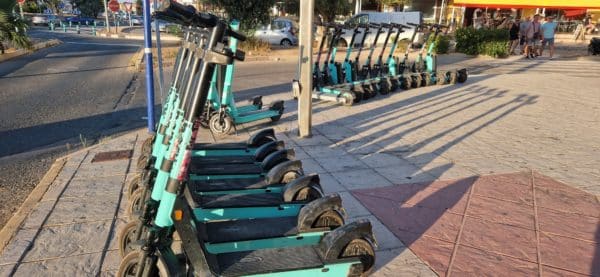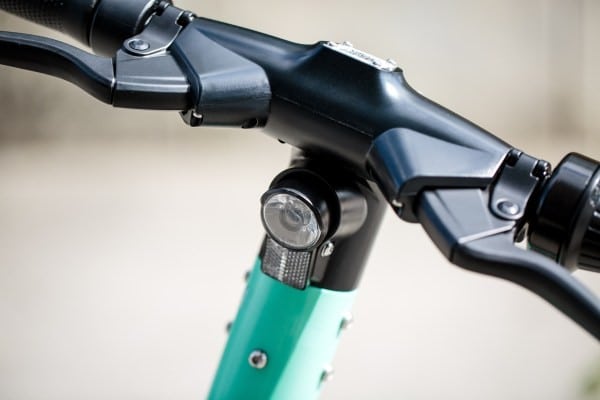We have been talking more and more about electric scooters recently, perhaps as a direct result of their growing numbers, but as well as knowing the obligations of the driver, it is important that we know what actually makes up one of these vehicles, technically referred to as VMP, or vehículos de movilidad personal, which directly translates to personal mobility vehicle.

As we have mentioned before, when we are talking about a VMP, we are not talking about such vehicles as mobility scooters used by those people who have reduced mobility. Nor are we talking about those which would technically be categorised as toys, or, in fact, as other vehicles. A VMP has a very specific set of technical characteristics.
When we are talking about the VMP, we are talking about those vehicles most commonly referred to as electric scooters, which do fall into the group, but there are others. In simple terms, a VMP has one or more wheels for individual use and propelled exclusively by electric motors with a maximum design speed between 6 and 25 km/h. If the vehicle cannot reach 6 kilometre per hour, it is classed as a toy, and not permitted on the roads.
If it can go faster than 25 km/h, it would have to be registered in the same way as a motor vehicle, most likely a moped, but in some cases even as a motorcycle, although, in Spain, this is not possible for all vehicles. For those which can be registered, they require ITV, number plates, insurance and a driving licence, amongst other requirements, but again, we are only talking about the more powerful vehicles.
When these micro mobility vehicles first entered Spain, there was little legislation, that has changed and continues to evolve, giving more control over these vehicles, all in the interest of safer practices. That is why there are now fewer larger or faster vehicles on the roads, for the reasons explained.
As of 22 January 2024, all VMPs that are marketed must be certified for use. Until this date it will be possible to circulate even if it is not available. They will require braking systems, reflectors, acoustic warning device, and lights.
What is considered a VMP?
We have already mentioned that in order to be classed as a VMP, the vehicle can only operate at a maximum speed of 25 km/h, with one or more wheels and propelled exclusively by electric motors (batteries up to 100 VDC and with an integrated charger up to 240 VAC input). They can only be equipped with a seat or saddle if they are equipped with self-balancing systems.
What are the technical characteristics of a VMP?
As has been said before, the maximum speed at which they can circulate is 25km/h, the speed at which the engine will stop driving the vehicle. In addition, it will have anti-handling systems for both speed and power.
They must have a visible information indicator that shows the speed at which it is going and the battery level.
All vehicles intended for personal transport must have two independent brakes, with a minimum deceleration of 3.5 m/s 2.
In addition, vehicles with more than 2 wheels must have a parking brake.
Personal mobility vehicles must be equipped with reflectors on the front (white), on both sides (white or auto yellow) and rear (red). In addition, the brake light must be differentiated or combined with the rear light.
For the VMP for the transport of goods or other services, they must have yellow auto side reflectors and red rear reflectors, on the edges and vertices of the load, which allow signalling and clearly distinguishing both the height and the width of the vehicle in low visibility situations.
In addition, these goods vehicles or other services must be compulsorily installed with front and rear direction indicators, popularly known as turn signals. They must also have rear-view mirrors and a reversing assistant.
Acoustic warning device for all types of VMP and in the case of merchandise or other services, they must also have a reversing warning device.
Parking stabilisation system. In order to avoid fallen VMPs in the middle of the streets and maintain a certain order in the cities, it has been established that VMPs with less than 3 wheels must have a stabilisation system consisting of a side kickstand or centre stand while parked.

The minimum established diameter of the wheels is set at 203.2mm and they must have a rough surface so that they adhere to the ground. In no case will the use of smooth tyres be allowed.
Safe folding. The VMP must have a double security system so that they are well coupled while it is being carried and avoid inadvertent openings.
All VMPs must have a unique, permanent, legible and clearly located factory marking with information on the maximum speed, the serial number, the certificate number, the year of construction and the make and model.
Identifier Holder. The VMP must have a space on the back of it to carry an identification or registration label.
In addition to all these technical characteristics, the manual details other characteristics more oriented to quality (structural integrity and electromagnetic compatibility, resistance to humidity, battery protection against high temperatures, non-slip surface…)
ENTRY INTO FORCE
The resolution which dictates these characteristics entered into force on 22 January 2022, however, a transitional regime is established, as stated in section 33 of the Resolution:
All vehicles marketed before 22 January 2024 may be used until 22 January 2027 even if they do not have a certificate.
All VMPs that are marketed after 22 January 2024 must be VMP brands and models that have been certified and, therefore, appear on www.dgt.es/vmp
As of 22 January 2027, only VMPs that comply with the provisions of this manual and, therefore, that have a certificate will be able to circulate.





